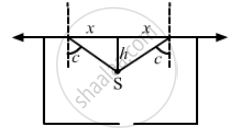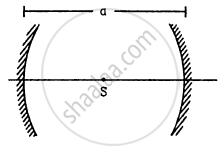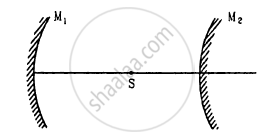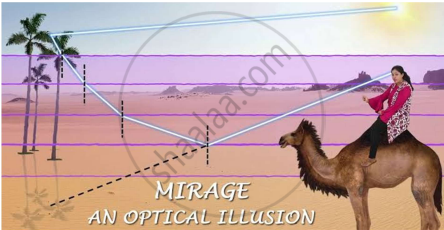Advertisements
Advertisements
Question
A point source is placed at a depth h below the surface of water (refractive index = μ). (a) Show that light escapes through a circular area on the water surface with its centre directly above the point source. (b) Find the angle subtended by a radius of the area on the source.
Solution
Given,
Refractive index is μ
(a)
Let the point source be P, which is placed at a depth of h from the surface of water.
Let us take x as the radius of the circular area.
and let θc be the critical angle.
Thus,
\[\frac{x}{h} = \tan \theta_c \]
\[\frac{x}{h} = \frac{\sin \theta_c}{\sqrt{1 - \sin^2 \theta_c}}\]
\[ = \frac{\frac{1}{\mu}}{\sqrt{1 - \frac{1}{\mu^2}}} \left( \because \sin \theta_c = \frac{1}{\mu} \right)\]
\[\frac{x}{h} = \frac{1}{\sqrt{\mu^2 - 1}}\]
\[x = \frac{h}{\sqrt{\mu^2 - 1}}\]
Clearly from figure, the light escapes through a circular area at a fixed distance r on the water surface, directly above the point source.
That makes a circle, the centre of which is just above P.
(b)
The angle subtended by the radius of the circular area on the point source P:
\[\Rightarrow \sin \theta_c = \frac{1}{\mu}\]
\[\Rightarrow \theta_c = \sin^{- 1} \left( \frac{1}{\mu} \right)\]
APPEARS IN
RELATED QUESTIONS
Draw the intensity distribution for the fringes produced in interference ?
Why does the Sun look reddish at sunset or sunrise ?
Suppose you are inside the water in a swimming pool near an edge. A friends is standing on the edge. Do you find your friend taller or shorter than his usual height?
The image formed by a concave mirror
A thin lens is made with a material having refractive index
\[\mu = 1 \cdot 5\]. Both the side are convex. It is dipped in water \[\mu = 1 \cdot 33\]. It will behave like
A candle flame 1.6 cm high is imaged in a ball bearing of diameter 0.4 cm. If the ball bearing is 20 cm away from the flame, find the location and the height of the image.
A 3 cm tall object is placed at a distance of 7.5 cm from a convex mirror of focal length 6 cm. Find the location, size and nature of the image.
A point source S is placed midway between two converging mirrors having equal focal length f as shown in figure. Find the values of d for which only one image is formed.
A converging mirror M1, a point source S and a diverging mirror M2 are arranged as shown in figure. The source is placed at a distance of 30 cm from M1. The focal length of each of the mirrors is 20 cm. Consider only the images formed by a maximum of two reflections. It is found that one image is formed on the source itself. (a) Find the distance between the two mirrors. (b) Find the location of the image formed by the single reflection from M2.

Light is incident from glass (μ = 1.50) to water (μ = 1.33). Find the range of the angle of deviation for which there are two angles of incidence.
A container contains water up to a height of 20 cm and there is a point source at the centre of the bottom of the container. A rubber ring of radius r floats centrally on the water. The ceiling of the room is 2.0 m above the water surface. (a) Find the radius of the shadow of the ring formed on the ceiling if r = 15 cm. (b) Find the maximum value of r for which the shadow of the ring is formed on the ceiling. Refractive index of water = 4/3.
A biconvex thick lens is constructed with glass (μ = 1.50). Each of the surfaces has a radius of 10 cm and the thickness at the middle is 5 cm. Locate the image of an object placed far away from the lens.
One end of a cylindrical glass rod (μ = 1.5) of radius 1.0 cm is rounded in the shape of a hemisphere. The rod is immersed in water (μ = 4/3) and an object is placed in the water along the axis of the rod at a distance of 8.0 cm from the rounded edge. Locate the image of the object.
Answer the following question in detail.
State the conditions under which a rainbow can be seen.
State any one difference between a primary rainbow and a secondary rainbow.
Explain the formation of primary and secondary rainbow.
| Case study: Mirage in deserts |
 |
|
To a distant observer, the light appears to be coming from somewhere below the ground. The observer naturally assumes that light is being reflected from the ground, say, by a pool of water near the tall object. Such inverted images of distant tall objects cause an optical illusion to the observer. This phenomenon is called mirage. This type of mirage is especially common in hot deserts. Based on the above facts, answer the following question : |
A diver at a depth 12 m inside water `(a_(µω) = 4/3)` sees the sky in a cone of semi-vertical angle
| Case study: Mirage in deserts |
 |
|
To a distant observer, the light appears to be coming from somewhere below the ground. The observer naturally assumes that light is being reflected from the ground, say, by a pool of water near the tall object. Such inverted images of distant tall objects cause an optical illusion to the observer. This phenomenon is called mirage. This type of mirage is especially common in hot deserts. Based on the above facts, answer the following question: |
The following figure shows a cross-section of a ‘light pipe’ made of a glass fiber of refractive index 1.68. The outer covering of the pipe is made of a material of refractive index 1.44. What is the range of the angles of the incident rays with the axis of the pipe for the following phenomena to occur.

